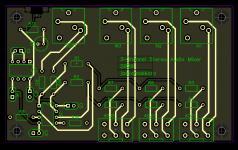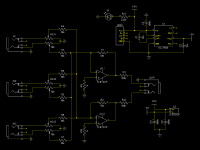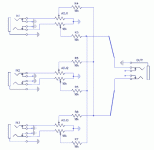Hi guys,
I tried to post this a while ago in a different subforum, but I realised that was the wrong one so I am reposting here - hope that's ok.
I recently made my own small 3-input stereo mixer for use at my desk so I can simultaneously have all of my computers connected to my speakers. The thing works OK and I'm pleased with it, but I am getting a high-pitched whine out of it that becomes noticable at fairly high volumes - it's honestly not hugely disturbing most of the time. However, I am not an expert with this stuff so I was wondering what the problem could be? Is it ground loop related? I have the mixer powered from a wall USB PSU, and I have 2 computers and an "Aux" connected to it. The whine seems to persist regardless of what inputs I have plugged into it. The speakers I am using are powered PC speakers, and they do not whine if I disconnect the mixer and plug in a different device with the same cable.
Here is a schematic of my design
Here is the PCB layout
If anyone has any ideas for why this might be happening, I'd love to hear them! Thanks in advance.
I tried to post this a while ago in a different subforum, but I realised that was the wrong one so I am reposting here - hope that's ok.
I recently made my own small 3-input stereo mixer for use at my desk so I can simultaneously have all of my computers connected to my speakers. The thing works OK and I'm pleased with it, but I am getting a high-pitched whine out of it that becomes noticable at fairly high volumes - it's honestly not hugely disturbing most of the time. However, I am not an expert with this stuff so I was wondering what the problem could be? Is it ground loop related? I have the mixer powered from a wall USB PSU, and I have 2 computers and an "Aux" connected to it. The whine seems to persist regardless of what inputs I have plugged into it. The speakers I am using are powered PC speakers, and they do not whine if I disconnect the mixer and plug in a different device with the same cable.
Here is a schematic of my design
Here is the PCB layout
If anyone has any ideas for why this might be happening, I'd love to hear them! Thanks in advance.
Last edited:
Hmmmm I played a 10kHz tone back through the speakers and the pitch isn't exactly the same but it honestly sounds pretty close. Is there some way to remedy this?
Edit - I also noticed that if I remove power from the mixer, then the whine stops. This might lend more credence to the ICL7660 being the problem.
Edit - I also noticed that if I remove power from the mixer, then the whine stops. This might lend more credence to the ICL7660 being the problem.
Last edited:
ICL766 don't even sound good in guitar effects pedals. A lot of power supply ripple on the output rails. A better, drop-in, pin-compatible part is MAX1044 (or perhaps other 1044 variants). They have better specs and can switch at higher than 20kHz, if you let them. If that doesn't work, then probably best to ditch the switched capacitor SMPS and find a better power supply. That's my two cents worth anyway, from having worked with the devices several years ago.
I take it you have tested the output of the ICL7660 with a scope under full load and all is well ?
It is mentioned in its specs that it does generate noise in "some " applications audio would surely be one of them.
The device can be serried and paralleled.
If that is okay then try it with one input at a time to eliminate any cross "pollution " .
Better with the MAX660.
It is mentioned in its specs that it does generate noise in "some " applications audio would surely be one of them.
The device can be serried and paralleled.
If that is okay then try it with one input at a time to eliminate any cross "pollution " .
Better with the MAX660.
Last edited:
Hi Duncan,
No I do not have the means to do that, unfortunately.
I tested the device with all combinations of inputs and the whine remains the same, I don't think it has anything to do with the inputs it seems to be something intrinsic to the power supply. I found some other references to people getting noise when using a 7660 in this way so I am basically convinced that the switching freqeuncy is leaking into the output. I would like to try with the MAX1044 but I was just wondering if I would be wasting my time - am I using components with enough power capabilities? My powered speakers have an input impedence of 10k, so at 1V the current would be 0.1mA, which would seem to be fine for this - but I honestly don't know what I'm talking about so some advice would be appreciated.
No I do not have the means to do that, unfortunately.
I tested the device with all combinations of inputs and the whine remains the same, I don't think it has anything to do with the inputs it seems to be something intrinsic to the power supply. I found some other references to people getting noise when using a 7660 in this way so I am basically convinced that the switching freqeuncy is leaking into the output. I would like to try with the MAX1044 but I was just wondering if I would be wasting my time - am I using components with enough power capabilities? My powered speakers have an input impedence of 10k, so at 1V the current would be 0.1mA, which would seem to be fine for this - but I honestly don't know what I'm talking about so some advice would be appreciated.
...if I replace the 7660 with the MAX1044 will there still be some power problems, or is this not a problem in this case?
There will still be some switching ripple on the power rails, but if at 20kHz you might not hear it. However, it would still go through your power amp and speakers which might affect sound quality in some way. You could likely try it easily enough if your aren't using pin-1 now (IIRC, its pin-1 function that differs between the two parts and allows the MAX part to switch at a little above 20kHz.
Generally speaking however, I am not aware of anyone using those type of power supply chips for serious audio use, maybe for toys. If you really need SMPS in order to run from wall wart power then you need to use a switched inductor type. However, it takes a lot of design expertise to do that well for audio. Most off the shelf, claimed-low-ripple, claimed-low-noise SMPS do not sound good without a lot of extra filtering and possibly some shielding.
Meanwell brand SMPS are mostly what serious audio designs use, but with extra output filtering. For an unskilled designer and or a designer without a lot of test equipment its probably a lot easier to get good sound using a conventional linear power supply. That's my 2-cents anyway.
Last edited:
OK thanks for the information. I think I will see with the 1044 how it sounds since I have already built the circuit, but for future reference how do you recommend generating the voltages linearly? Do you need to switch to an AC input (say 12V) and rectify then regulate the +ve and-ve voltages down to +-5V?
If you use linear power supplies then there is usually no reason to be confined to +-5v for opamp power. Maybe +5v or +3.3v for logic and or low voltage devices.
For typical audio opamps, usually somewhere between roughly +-11v to +-15v is most common and tends to sound best. The + opamp rail can be dropped down to 5v or 3.3v using another small regulator if needed for low voltage devices. Something like that anyway. Depends on what you end up wanting to do.
For typical audio opamps, usually somewhere between roughly +-11v to +-15v is most common and tends to sound best. The + opamp rail can be dropped down to 5v or 3.3v using another small regulator if needed for low voltage devices. Something like that anyway. Depends on what you end up wanting to do.
Hmmmm I played a 10kHz tone back through the speakers and the pitch isn't exactly the same but it honestly sounds pretty close. Is there some way to remedy this?
Edit - I also noticed that if I remove power from the mixer, then the whine stops. This might lend more credence to the ICL7660 being the problem.
i designed a usb scope frontend using 7660.
i was getting 10khz on scope signal.
turned out i had run audio signal very close 7660 and was picking up the 10khz
rerouted track and that fixed it.
i designed a usb scope frontend using 7660.
i was getting 10khz on scope signal.
turned out i had run audio signal very close 7660 and was picking up the 10khz
rerouted track and that fixed it.
To be fair, my audio signals do run close to the 7990, maybe if I redo the board in the future I will move them.
If you use linear power supplies then there is usually no reason to be confined to +-5v for opamp power. Maybe +5v or +3.3v for logic and or low voltage devices.
For typical audio opamps, usually somewhere between roughly +-11v to +-15v is most common and tends to sound best. The + opamp rail can be dropped down to 5v or 3.3v using another small regulator if needed for low voltage devices. Something like that anyway. Depends on what you end up wanting to do.
OK, but what kind of method would you recommend for generating these voltages?
after looking at pcb the 7660 isnt that close as it was when i had problems.
you need to scope the pcb and find where the hf is coming from.
you need to scope the pcb and find where the hf is coming from.
Your comment on--quote-"will there be enough power " is relevant.
Not in my book it wont not by a long chalk -
TLO72 -current used in EACH channel=1.5ma (approx ) so double that =3ma ---now multiply by THREE = 9ma , limit on the MAX 1044=10ma.
I know of no sane design engineer nor for that matter technician designing their own product for sale to the public who would put their whole reputation on the line for----ONE ma "safety margin " .
Dont take my word ask D.Self who spent several issues and an article on using simple power supplies with large amounts of spare current available - big clash with JLH who advocated stabilized power supplies .
If others think its "okay " let them when I build something its over-engineered in every sense from the hardware to the design of the active and passive components that way no blame can be attributed to me on that part.
Not in my book it wont not by a long chalk -
TLO72 -current used in EACH channel=1.5ma (approx ) so double that =3ma ---now multiply by THREE = 9ma , limit on the MAX 1044=10ma.
I know of no sane design engineer nor for that matter technician designing their own product for sale to the public who would put their whole reputation on the line for----ONE ma "safety margin " .
Dont take my word ask D.Self who spent several issues and an article on using simple power supplies with large amounts of spare current available - big clash with JLH who advocated stabilized power supplies .
If others think its "okay " let them when I build something its over-engineered in every sense from the hardware to the design of the active and passive components that way no blame can be attributed to me on that part.
Hi,
Thanks again for the input, Duncan. I didn't notice your edit to your previous post until now, where you mention the MAX660, that IC seems ideal and I will test my current design with that IC as a drop-down replacement for the ICL7660. I'll let you know how I get on.
Thanks
Thanks again for the input, Duncan. I didn't notice your edit to your previous post until now, where you mention the MAX660, that IC seems ideal and I will test my current design with that IC as a drop-down replacement for the ICL7660. I'll let you know how I get on.
Thanks
MAX1681 is another possible, very high switching frequency, 125mA output so won't be even remotely struggling.
Thanks, Mark - only problem with the 1681 is that I can't find it in small quantities here in Finland, so I will try first with the 660.
- Home
- Source & Line
- Analog Line Level
- High-pitched whine from DIY mixer



